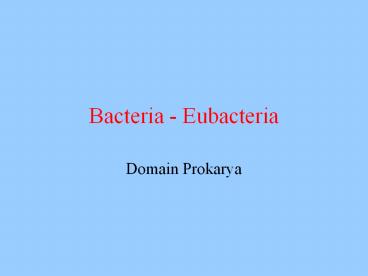Bacteria - Eubacteria PowerPoint PPT Presentation
Title: Bacteria - Eubacteria
1
Bacteria - Eubacteria
- Domain Prokarya
2
Shifting Kingdoms
Lumpers
Splitters
2 3 5 6 8
Bacteria Bacteria Bacteria Bacteria Bacteria
Archaebacteria Archaebacteria Archaebacteria Archaebacteria Archaebacteria
Archezoans Archezoans Archezoans Archezoans Archezoans
Euglenoids Euglenoids Euglenoids Euglenoids Euglenoids
Chrysophytes Chrysophytes Chrysophytes Chrysophytes Chrysophytes
Green Algae Green Algae Green Algae Green Algae Green Algae
Brown Algae Brown Algae Brown Algae Brown Algae Brown Algae
Red algae Red algae Red algae Red algae Red algae
Slime Molds Slime Molds Slime Molds Slime Molds Slime Molds
True Fungi True Fungi True Fungi True Fungi True Fungi
Bryophytes Bryophytes Bryophytes Bryophytes Bryophytes
Tracheophytes Tracheophytes Tracheophytes Tracheophytes Tracheophytes
Protozoans Protozoans Protozoans Protozoans Protozoans
Myxozoans Myxozoans Myxozoans Myxozoans Myxozoans
Multicellular Animals Multicellular Animals Multicellular Animals Multicellular Animals Multicellular Animals
3
How Many Kingdoms?
Extant
Extinct
Long Time with Prokaryotes only
Original Cell
4
Bacteria - Eubacteria
- Ancient fossils 3.5 billion years b.p.
- Archetype for prokaryotic organisms
- Phototrophs
- Chemoautotrophs
- Heterotrophs
- Saprobes
- Parasites (bacteria benefit, host harmed)
- Commensals (bacteria benefit, host unharmed)
- Mutualists (bacteria and host both benefit)
- Unicellular, colonial, filamentous
- Bacillus, coccus, spirillum
5
Cell Sizes
Mycoplasma 0.3-0.8 µm
E. coli 1x2 µm
Cyanobacteria 10 µm diam
Plant Cell 30x75 µm
Obviously eukaryotic Nucleus present Mitochondrion
? Bacterium Chloroplast ? Cyanobacterium
6
Cell Shapes
Coccus - cocci
Bacillus - bacillus
Spirillum - spirilli
Vibrio - vibrios
7
http//www.up.ac.za/academic/electron/bacteria.jpg
8
Leptospira
http//phil.cdc.gov/PHIL_Images/02142002/00001/PHI
L_138.tif
9
http//www.designthatmatters.org/proto_portfolio/c
holera_treatment/multimedia/vibrio_cholerae.jpg
Vibrio cholerae
Helicobacter pylori
http//helico.gsnu.ac.kr/
10
Cell Associations
Coccus
Diplococcus
Streptococcus - filamentous
Staphylococcus - colonial
?
Streptobacillus
11
http//www.hhs.gov/asphep/presentation/images/bact
eria.jpg
12
Cell Structure Boundary
Mycoplasma
cell membrane bilayer lipopolysaccharide
transport proteins
cytosol
regulates input/output
Gram Positive
Gram Negative
cell wall-murein peptidoglycan muramic acid
- peptide
prevents bursting turgor pressure penicillin
sensitive
additional membrane bilayer lipopolysaccharide
releases dye
13
Cell Structure Boundary Defenses
mucoid polysaccharides
cell adhesion chemical resistance -
defense desiccation resistance
spore coat DNA other materials
exterior may be lost frozen for long
periods boiled for long periods desiccated for
long periods then germinates to new cell
Bacillus anthracis
14
?
?
http//library.thinkquest.org/3564/Cells/cell91.gi
f
15
Cell Structure Movement
hook
directional rotation?
basal rings and rod
anchorage rotation
stiff helical flagellum
flagellin protein
is rotated by motor apparatus in the membrane
by H ATPase at rates of 200-1700 rps
(gt12,000 rpm!)
Taxis movement toward stimulus
Exceptions
phototaxis movement toward light
myxomycetes, some cyanobacteria use slime, but
how? spirochetes have flexible internal
microtubules (endosymbiotic source of
flagella in eukaryotes?) ((gut parasite in
termites have spirochete symbiosis))
chemotaxis movement to chemicals
16
Lophotrichous flagella found at one end of the
cell
http//msucares.com/lawn/tree_diseases/images/bact
eria.gif
17
Amphitrichous flagella at both ends (but not
many on sides)
http//www.biophysics.uwa.edu.au/STAWA/scans/40540
a.jpg
Peritrichous flagella all around cell
http//www.biophysics.uwa.edu.au/STAWA/scans/40545
a.jpg
18
Prokaryotic Growth
- Cells are generally very small
- Cells may double in size but only before binary
fission - Growth mostly in terms of cell number or colony
size, etc. - Doubling time in cell numbers may be 20 minutes
in ideal conditions - Could quickly take over the earth if conditions
could remain ideal - Very competitive in ideal environments
- Ultimate survivors - 3.5 billion years!
19
Cell Structure Nucleoid
Nucleoid - genome
one circular DNA molecule no histone protein
association attached to cell membrane
transcription by RNA polymerase
replication by DNA polymerase
separation of chromosomes
cytokinesis by furrowing
- Process called binary fission
- NOT mitosis!
- Genome and copy are identical
- Genome is haploid
- There is no synapsis
- There is no recombination
70S Ribosome
rRNA protein ribozymes
translation of mRNA into protein
20
nucleoids
initial furrowing
furrowing complete
http//www.nature.com/news/2002/020722/full/020722
-11.html

